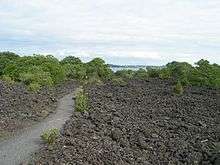Primary succession


Primary succession is one of two types of biological and ecological succession of plant life, occurring in an environment in which new substrate devoid of vegetation and other organisms usually lacking soil, such as a lava flow or area left from retreated glacier, is deposited. In other words, it is the gradual growth of an ecosystem over a longer period.[1][2]
In contrast, secondary succession occurs on substrate that previously supported vegetation before an ecological disturbance from smaller things like floods, hurricanes, tornadoes, and fires which destroyed the plant life.[3]
Occurrence
In primary succession pioneer species like lichen, algae and fungi as well as other abiotic factors like wind and water start to "normalize" the habitat. Primary succession begins on rock formations, such as volcanoes or mountains, or in a place with no organisms or soil. This creates conditions nearer optimum for vascular plant growth; pedogenesis or the formation of soil is the most momentous process.
These pioneer plants are then dominated and often replaced by plants better adapted to less harsh conditions, these plants include vascular plants like grasses and some shrubs that are able to live in thin soils that are often mineral based.
For example, spores of lichen or fungus, being the pioneer species, are spread onto a land of rocks. Then, the rocks are broken down into smaller pieces and organic matter gradually accumulates, favouring the growth of larger plants like grasses, ferns and herbs. These plants further improve the habitat and help the adaptation of larger vascular plants like shrubs, or even medium- or mountainous-sized trees. More beasts are then attracted to the place and finally a climax community is reached.
Example
A good example of primary succession takes place after a volcano has erupted. The lava flows into the ocean and hardens into new land. The resulting barren land is first colonized by pioneer plants which pave the way for later, less hardy plants, such as hardwood trees, by facilitating pedogenesis, especially through the biotic acceleration of weathering and the addition of organic debris to the surface regolith. An example of primary succession is the island of Surtsey, which is an island formed in 1963 after a volcanic eruption from beneath the sea. Surtsey is off the South coast of Iceland and is being monitored to observe primary succession in progress. About thirty species of plant had become established by 2008 and more species continue to arrive, at a typical rate of roughly 2–5 new species per year.[4]
See also
References
- ↑ "Biology Online Dictionary". Biology Online. Retrieved 12 October 2011.
- ↑ Walker, Lawrence R.; del Moral, Roger. "Primary Succession". Encyclopedia of Life Sciences. doi:10.1002/9780470015902.a0003181.pub2. Retrieved 9 December 2015.
- ↑ Baldocchi, Dennis. "Ecosystem Succession: Who/What is Where and When" (PDF). Biomet Lab, University of California, Berkeley. Retrieved 9 December 2015.
- ↑ The volcano island: Surtsey, Iceland: Plants, Our Beautiful World, retrieved 2016-02-02